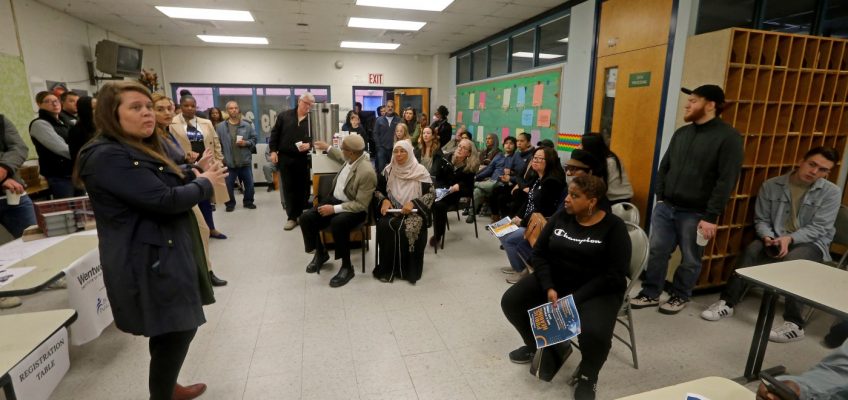A long list of students flocked to the latest Boston School Committee meeting to join the growing number of critics of exam school admissions changes and plans to move to the O’Bryant School to West Roxbury.
Both topics have been controversial touchpoints for parents, teachers and students over the last several months.
Exam school admissions headlined the last school committee meeting, with Committee Member Brandon Cardet-Hernandez and many parents pushing frustrations with the policy and lack of action.
The complicated system aims to more equitably distribute seats by dividing students into geographic socioeconomic tiers and awarding extra points to students in certain circumstances
Many have argued the changes do not actually equitably distribute seats, unfairly advantage certain students and make it nigh impossible for certain sets of students to get into the schools.
“I have so many friends and teammates from my street in my neighborhood who got into exam schools with scores much lower than mine because they attended a bonus-point school,” said Eliot School seventh grader Grace Nothnagel, referring to the 10-point advantage awarded to students at a school with over 40% economically disadvantaged students.
It’s a sentiment echoed by other students, many from the same school, who said they felt like “an unattended consequence” of the policy.
“Why are they allowed to attend an exam schools but I’m not? What could I have done differently? This policy gave me zero chance,” she said.
Superintendent Mary Skipper noted in her report Wednesday that her team is “gathering the information” on the timeline and rationale behind the exam school admissions changes and expects it to be ready before the next committee meeting in two weeks.
Students also rallied around many critiques of the O’Bryant School move, emphasizing the concern that moving the district’s most diverse exam school from Roxbury to the less central, less diverse West Roxbury location has high community and transportation costs.
District leadership announced the proposal to move the O’Bryant to the vacant West Roxbury Education Complex in June.
“We wish our parents could be here tonight to get their testimony,” said O’Bryant senior Jamie Martin, noting that many of their parents work long hours or are not fluent in English. “And we are here instead because this is our school, and we wanted to stay in Roxbury. The opportunity that the school offers is so special because the area we live in.”
Martin noted that she hopes her younger siblings can have the same opportunities she’s had at the school in Roxbury because it’s a school “where we can all belong.”
Later on, BPS officials presented the district’s new Inclusive Education Plan, based on recommendations from the district’s extended studies into disparities for students with disabilities, multilingual learners and those in historically underserved groups.
Related Articles
Boston exam school admissions policy ire hits school committee
BPS leaders present mixed MCAS and accountability data, plan to ‘accelerate progress’
‘Massachusetts needs help:’ State senate president speaks on migrant crisis
Judge allows Mission Hill bullying, sexual abuse case to move forward over motion to dismiss
‘Still segregated:’ Leaders reframe history of school desegregation, busing ahead of 50th anniversary
Skipper called the plan “complex” and “urgent” and said it “serves as a roadmap for the district to deliver on the promise of providing an excellent, inclusive and equitable education in the least-restrictive environment for students with disabilities, especially our black and brown students, and our multilingual learners with disability.”
The plan makes four broad shifts, BPS staff outlined: increasing access to grade-level learning; ensuring the inclusive delivery of interventions, supports and services; engaging in team-based planning and collaboration; and resetting district infrastructure with systems of support and accountability.
The issues are “more than 100 years rooted in systemic racial disparities,” she continued, and the district must recognize things like culture and experience as assets and create a system to educate students based on “their individual needs and diversity.”
Staff pointed to data points marking stark disparities in BPS’s inclusive education. Black male students are 3.13 times more likely to be identified as having an emotional impairment, speakers said, and multilingual learners are 2.5 times more likely to be identified as having a communications disability.
The plan will be implemented across the district over the next five school years.


Leave a Reply